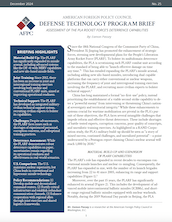Since the 18th National Congress of the Communist Party of China, President Xi Jinping has promoted the enhancement of strategic forces, stressing new developmental plans for the People’s Liberation Army Rocket Force (PLARF). To bolster its multidomain deterrence capabilities, the PLA is scrutinizing each PLARF combat unit according to the standard of being able to “launch effective damage on time any time.” This has entailed expanding the PLARF’s missile arsenal, including adding new silo-based missiles, introducing dual-capable platforms that can carry either conventional or nuclear weapons, increasing the frequency of joint and interregional training exercises involving the PLARF, and recruiting more civilian experts to bolster technical support.
China has long maintained a formal “no-first-use” policy, instead prioritizing the establishment of a viable second-strike capability to deter a “powerful enemy” from intervening or threatening China’s national sovereignty and territorial integrity. While these enhancements to systems crucial for wartime mobilization are pivotal in the PLA’s pursuit of these objectives, the PLA faces several intangible challenges that impede reform and effective threat deterrence. These include shortages of battle-tested experts, corruption concerns, poor quality of conscripts, and unrealistic training exercises. As highlighted in a RAND Corporation study, the PLA’s military build-up should be seen as “a story of mixed success, continued challenges, and unrealized potential”—a point underscored by a Pentagon report claiming China’s nuclear arsenal will reach 1,000 by 2030.
